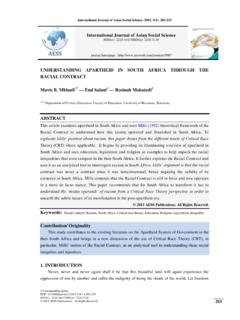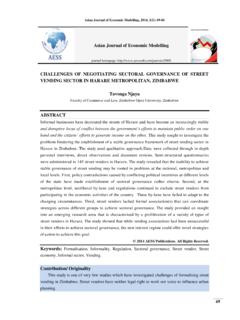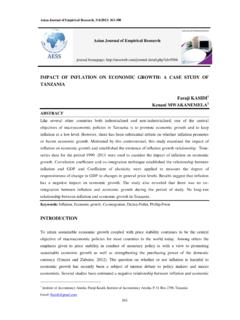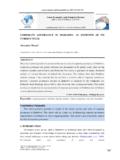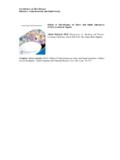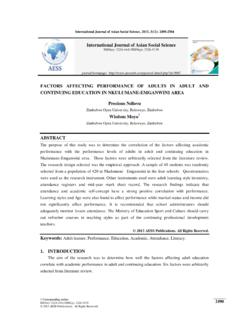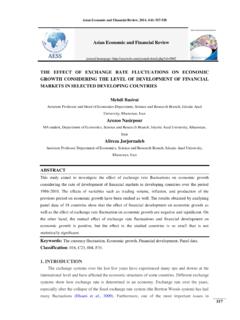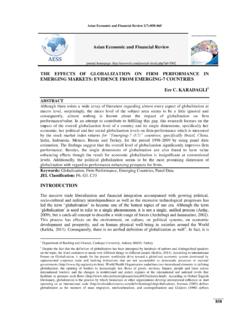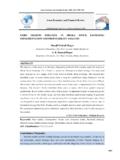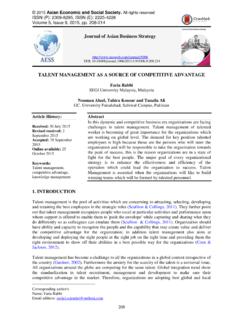Transcription of FACTORS AFFECTING THE COMPETITIVENESS OF THE FOOD …
1 Journal of Asian Scientific Research, 2015, 5(4):185-197. Journal of Asian Scientific Research ISSN(e): 2223-1331/ISSN(p): 2226-5724. journal homepage: FACTORS AFFECTING THE COMPETITIVENESS OF THE FOOD industry . BY USING PORTER'S five FORCES MODEL CASE STUDY IN HAMADAN. PROVINCE, IRAN. Meysam Jafari Eskandari1 --- Meysam Miri2 --- Sedigheh Gholami3 --- Hamid Reza Sajadi Nia4. 1. Assistant Professor, Department of Industrial Engineering, Payam Noor University, Tehran, Iran 2. Master of Industrial Engineering, Payam Noor University, Tehran, Iran 3,4. Master student of Industrial Engineering, Payam Noor University, Tehran, Iran ABSTRACT. COMPETITIVENESS can be defined as a firm's success in comparison with other firms in the industry , national and international scene.
2 According to the internationalization of markets, the loss of long distances and countries borders and simplify the entry of firms to international competition than in previous decades, In this study, the researcher will study FACTORS AFFECTING the COMPETITIVENESS of the food industry by using Michael Porter's competitive forces model includes five axes: competition among competitors, bargaining power of buyers, bargaining power of raw material suppliers, threat of entry of new competitors and the threat of the substitute products and Next, the researcher presents strategies to improve competitive situation of the food industry with primary data (such as the Internet, articles in the field, etc.)
3 And open interviews with several experts in the food industry that can be concluded each Porter's five forces play a role in improving COMPETITIVENESS . But the competition between competitors is identified as the most important indicator for the industry that can be used to create opportunities for the firm and play a better performance than the competitors in the competition scene. In addition to Porter's five competitive forces, we could also mention the most important FACTORS in the success of firms such as: the quality and reasonable prices, modern technology, have strong management, rich investors and government support. 2015 AESS Publications. All Rights Reserved.
4 Keywords: Michael Porter's competitive model competition of competitors, Threat of new entrants, Threat of the substitute goods, Purchasing power of buyer's power of suppliers of raw materials. Corresponding author DOI: ISSN(e): 2223-1331/ISSN(p): 2226-5724 185. 2015 AESS Publications. All Rights Reserved. Journal of Asian Scientific Research, 2015, 5(4):185-197. Contribution/ Originality In this paper, using Porter's COMPETITIVENESS model Conditions and approach to COMPETITIVENESS in food industry is examined and concluded each Porter's five forces play a role in improving COMPETITIVENESS . But the competition between competitors is identified as the most important indicator.
5 1. INTRODUCTION. With different theoretical study of Scholars and Researchers shows that there is no single definition and interpretations of COMPETITIVENESS . In general, COMPETITIVENESS is the abilities that a business, industry , region or country have them and can maintain it to make high returns on FACTORS of production in international competition and put their Manpowers in a good condition. Khodamoradi, et al. [1], Moradi and Shafahi [2] COMPETITIVENESS is namely: the competences and power and ability of a firm. The other competitors are prevented from having access to it or less than the firm. According to Michael Porter's opinion on COMPETITIVENESS FACTORS are divided into five categories that include: competition among competitors, bargaining power of buyers, bargaining power of raw material suppliers, threat of entry of new competitors and the threat of the substitute products that with attention to each of these FACTORS , the firm is closer to achievement of successful and entrance of the competition field.
6 Intensive competition from the five -factor indicates the industry structure and the nature of competitive relationships in the industry . Despite the impact of Porter's competitive model on COMPETITIVENESS , as well as other FACTORS contribute to success of organizations in moving toward foreign markets and to accelerate this process that Researchers from different perspectives have received part of it. [3]. Among these FACTORS can be pointed to management FACTORS such as: internal FACTORS and external FACTORS of the organization's environment. Karadeniz and G er [4] That external FACTORS can be interpreted as the negative or positive forces that impact on the company's growth in COMPETITIVENESS field.
7 Of these FACTORS , it can be noted that the intensity of competition, government policies and growth opportunities. Note, however, based on interviews conducted , we reach the conclusion that in addition to Porter's five forces and its sub-indices, as the most important FACTORS AFFECTING COMPETITIVENESS , also we can mention: having strong management, good quality and reasonable price, capital-rich, efficient access to modern technology, skilled manpower. One of the priorities and agendas of governments in developing countries is paying special attention to the food industry that the main reasons are: 1. Increasing importance of the food industry in terms of job creation and increased participation directly or indirectly in the production of national income.
8 2. Changes in the composition of world exports of raw materials to products with higher added value. 3. Facing developing countries with limited resources and the need to plan for the optimal use of them is one of the issues in developing countries and the lack and absence of management 2015 AESS Publications. All Rights Reserved. 186. Journal of Asian Scientific Research, 2015, 5(4):185-197. skills in large-scale investments. The expansion of industrial activities related to resources such as the food industry , especially in small quantities, is the Governments priorities. 4. Rising income levels and changing lifestyle patterns guide's changes in consumer behavior towards food products with quality higher and more nutritious.
9 [5]. The present research aims to develop theories and propose a comprehensive model, in addition to combining existing views, offers a comprehensive conclusion. For this purpose, we defined the issue of COMPETITIVENESS , industry and Michael Porter's five forces competitive and illustrated its conceptual aspects. Using the existing literature, is to identify the FACTORS and criteria of the researcher's opinion and the results of an interview with managers, food industry and research experts work in the areas of COMPETITIVENESS , provide usable and reliable and comprehensive results. 2. RESEARCH CONDUCTED IN THE FIELD OF COMPETITIVENESS . 1) In a study entitled: COMPETITIVENESS of Iranian industries in the process of accession to the WTO by Nikooeghbal and Valibeigi have proposed way to identify vulnerable industry COMPETITIVENESS , guidelines to reasonable support the COMPETITIVENESS of industries, adoption preventive measures and policies to reduce potential damages.
10 [6]. 2) In a study entitled: Analysis of automotive industry competition based on Michael Porter's model by Wafa et al. have proposed analysis of competitive AFFECTING forces on the automotive industry with using five competitive forces. [7]. 3) In a study titled: " Export COMPETITIVENESS of Food industry " by Safari and Dehghan to identify indicators of RCA of stable market share, business plan of products have a competitive advantage, have proposed the operation and evaluation indicators for using the their research results to improve investment in export and production. [8]. 4) In a study entitled: Ranking of FACTORS AFFECTING the COMPETITIVENESS of carpet industry using topsis of fuzzy by Haghshenas and Saeedi have carried ranking of FACTORS AFFECTING the COMPETITIVENESS in handmade carpet industry based on multi-criteria decision of fuzzy.
